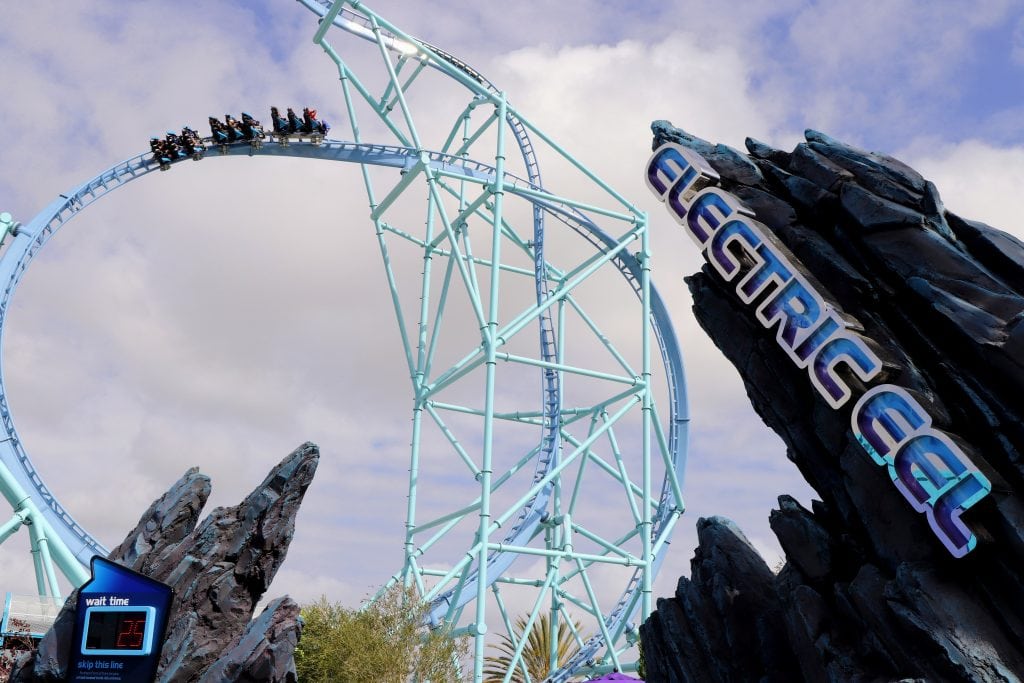Skift Take
SeaWorld is rebounding, with higher attendance and revenue than a year ago. Will it last? And how much free beer will the continued recovery take?
As they spoke to analysts Monday, executives at SeaWorld Entertainment had something unusual to discuss: a second consecutive quarter of good news.
Attendance continued to increase in the second quarter, revenue was up, and the theme park operator swung to a profit after reporting a loss in the same quarter of 2017. Shares soared 16.85 percent to end the day at $24.69, the highest close in nearly four years.
“We’re encouraged by the progress and the continued momentum we see in the business as we execute on our key initiatives, and we seek significant opportunity for continued improvement and growth going forward,” Interim CEO John Reilly said during the call.
SeaWorld had been in a prolonged slump following the 2013 release of the documentary Blackfish, which was critical of its handling of captive orcas. Attendance dropped, public perception plummeted, protests abounded, revenue tanked, and the company announced it would no longer breed its iconic killer whales or use them in theatrical shows.
Reilly, who was named to the position in February after former CEO Joel Manby stepped down, said the improvements came about thanks to efforts on several fronts. Those included new rides and events; a fresh marketing and communications push; and “new strategic pricing strategies.”
Another popular draw, Reilly said, was this: “We brought back free beer as a summer promotion in Tampa and Orlando, and you can imagine, this limited-time promotion has been popular with our guests.”
The admission plan — executives described it as “attractive pricing” — meant that per capita admission dropped 4 percent to $35.21 across the company’s portfolio. But in-park per capita spending increased 6.5 percent to $25.90. SeaWorld’s portfolio includes 12 theme and water parks across the U.S., including SeaWorld, Busch Gardens, and Sesame Place.
Chief Financial Officer Marc Swanson said the company plans to keep optimizing that in-park spending with food, merchandise, front-of-line options, and interactive animal experiences. But, he said, there will be times when the per-person admissions could drop.
“We believe that we have some of the strongest value propositions in our markets and some of the strongest value propositions in the industry,” Reilly said. “And part of our pricing optimization is better communicating the strong value that we’re offering.”
SeaWorld Orlando is selling a two-park ticket that also includes admission to its water park, Aquatica, or its Tampa parks for $99.99. That’s significantly less expensive than tickets to Universal or Disney, where admission for one day tops $100.
For the quarter, attendance increased 4.8 percent to 6.4 million visitors, despite bad weather and the impact of Easter timing, which fell earlier this year than last. Revenue increased nearly 5 percent to about $392 million, above analyst expectations. Profit jumped to $22.7 million, up from a loss of nearly $176 million — which included an impairment charge — in the second quarter of 2017.
International attendance, which has been a drag in recent years, also increased.
Executives also announced a renewed focus on cost. They had announced $25 million in targeted cost-cutting last year, but increased that to $50 million.
“We have spent considerable time analyzing our cost structure at the corporate and park level, and, have identified significant opportunities to streamline our business, reduce redundant expenses and operate more efficiently,” Swanson said.
A 2020 Goal
The company also outlined its long-term plans, setting a goal of $475 million-$500 million in adjusted earnings before interest, taxes, depreciation, and amortization by the end of 2020.
To reach that goal, SeaWorld needs about a 1 percent increase in attendance each year, plus it needs to get back 20-25 percent of the attendance it lost over the last five years. Revenue per capita needs to grow about 1.75 to 2 percent a year, while costs need to drop by that $50 million.
“I think the outlook you guys have for 2020 is the biggest EBITDA growth over a three-year period from any public theme park company that I can recall anyway at this point,” said Barton Crockett, an analyst with B. Riley FBR. “So it’s a tremendous kind of rebound that you see and that’s impressive.”
SEC Settlement in the Works
After trumpeting the quarter’s performance, the company revealed that it had reached an “agreement in principle” with the Securities and Exchange Commission to settle potential charges coming out of an investigation into possible securities law violations.
SeaWorld recorded an estimated $4 million liability during the quarter, though an agreement is still subject to SEC approval.
The company had warned in April that the regulatory commission intended to take some sort of enforcement action. The SEC and Department of Justice sent subpoenas in 2017 to SeaWorld related to investigations about former executives’ trades of company shares, and disclosures and public statements about the impact of Blackfish.
Representatives for SeaWorld and the SEC would not say anything else about the agreement Monday.
“It’s also important for me to note that the company and the staff are still working to document the proposed settlement and the this agreement is still subject to approval by the commission,” Reilly said during the call. “There’s no assurance that the settlement will be finalized and/or approved by the commission or that any final settlement will not have different or additional terms.”
This story has been updated with the correct name for B. Riley FBR.
The Daily Newsletter
Our daily coverage of the global travel industry. Written by editors and analysts from across Skift’s brands.
Have a confidential tip for Skift? Get in touch
Tags: blackfish, earnings, seaworld, theme parks
Photo credit: The Electric Eel roller coaster, which opened this year, is shown in a photo from May 2018. SeaWorld said its new rides helped drive an increase in attendance in the second quarter. Prayitno Photography / Flickr
